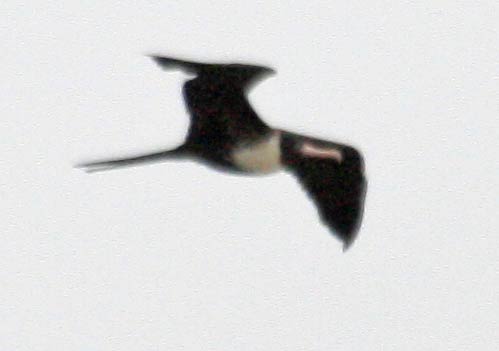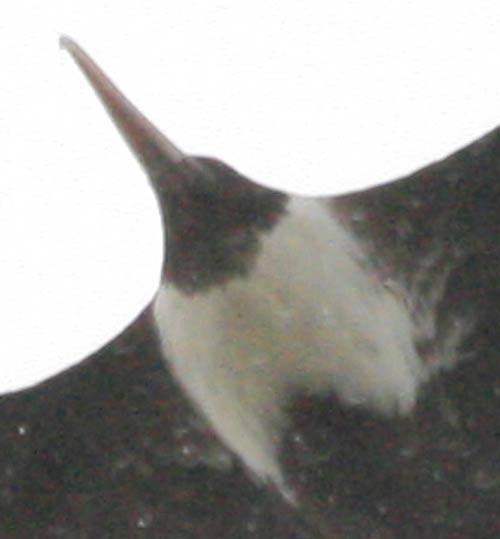
The information presented here all resulted from my discovery of a pink-billed Frigatebird Fregata sp. at the end of the Quintana Jetty, Freeport, Brazoria county, Texas on August 19, 2008 - here are a couple of my pics of it:


I consulted with a number of experienced birders, all of whom felt it had to be a Lesser Frigatebird (note that during this period I shared some not-too-great images that suggested the orbital ring color was reddish). Most of those persons had extensive experience with Magnificent, one had extensive experience with Lesser and one with both.
In Early September Mark Bartosik published MUCH better images of the same individual from August 30 and September 01 - CLICK HERE to see his presentation on this bird (but the data at that site may change subsequent to the publication of this page).
Three things became evident from Marks terrific photos:
1) the bird has lost its right eye.
2) the orbital rings are grayish, not reddish.
3) Two of Mark's pics show a thin white collar extending around the back of the neck.
Note that in the ID article by David James it states for Lesser Frigatebird that the orbital ring is usually red but often bluish in some populations, and that it always has a white collar. As yet I do not have the Howell (1994) article at-hand, but I do have the article by Faulkner (2006) in which he says "Moreover, unlike in Magnificent Frigatebird, the Wyoming frigatebird has a reddish orbital ring, pink bill, and extensive white collar dorsally. Magnificent shows a blue orbital ring, grayish bill, and a reduced gray hindcollar (Howell 1994)". A number of very good birders have expressed to me privately and publicly that the Quintana pink-billed bird had too much white in the axillaries for adult female Magnificent, and/or that they'd never seen or heard of Magnificents with pink bills or white collars - seemingly corroborating the statments attributed to Howell by Faulkner above.
I recently had a conversation with a very experienced central Texas coast birder who sees more Magnificent Frigatebirds than most in Texas, and I was surprised to hear from them that a couple of times females with a pinkish hue to the bill have been noticed. I decided to search the Internet - applying due caution to claimed identifications - for images of Magnificents in order to assess the variation represented there. I found the following images that seem to establish that some Magnificent Frigatebirds can have a white collar, and that some can have a pink or pinkish bill (there seemed a tendency for photos of birds from the southern Caribbean to more-often show a pinkish or warm hue to the bill, while almost all from the Pacific had blue-grayish-looking bills).
Take a look at these locations to see some examples; please contact me if you feel that any of these birds are not Magnificents.
CLICK HERE to see a bird with a huge white collar (this web page is the first of 8 images of a bird trying to take a fish - use the "next" option to see the other pics).
CLICK HERE to see a bird with a narrow white collar (the collar is possibly incomplete, but is very extensive).
CLICK HERE to see a bird with a narrow white collar.
CLICK HERE to see a pink-billed bird from Cuba.
CLICK HERE to see a pinkish-billed bird from Dominican Republic.
CLICK HERE to see a pink-billed bird from the Galapagos that also has a narrow white collar.
Regarding the matter of white in the axillaries; it is not hard at all to find photos of adult female Magnificents that have as much or more white in this area than the pink-billed bird from Quintana - indeed a couple seemed to have some small solid white patches at the base of the axillaries.
I did not find any Magnificents with red orbital rings and this may be the only Lesser feature not found in Magnificent... Given my recent experience with the other ID features above it would not shock me to learn that some Magnificents can have red or reddish orbital rings - the real question is: can any Magnificent have a combination of reddish orbital, pink bill, and white collar, with fairly strong white axillaries? If such a beast exists, then it would be identical to adult female Lesser in everything but size (and why stop there? maybe there are runt Magnificents...)
REFERENCES:
Brennan, C. and J. Schultz. 2006. A second North American record for Lesser Frigatebird (Fregata arid). North American Birds 60: 164-165
Faulkner, D. 2006. Reassessment of a frigatebird record for Wyoming: Lesser Frigatebird (Fregata arid). North American Birds 60: 328-330
Howell, S.N.G. 1994 A new look at an old problem BIRDING 26: 402-415 (ID of Great and Magnificent Frigatebirds; issue 6)
James, D. J. 2004. Identification of Christmas Island, Great and Lesser Frigatebirds. Birding Asia 1: 22-38
Sullivan, B. L., M. J. Iliff, P. L. Ralf and S. T. Kelling. 2007. A Lesser Frigatebird (Fregata arid) in California: a first for the state and fourth for North America. North American Birds 61: 540-547